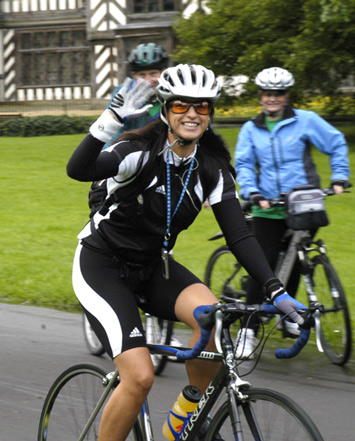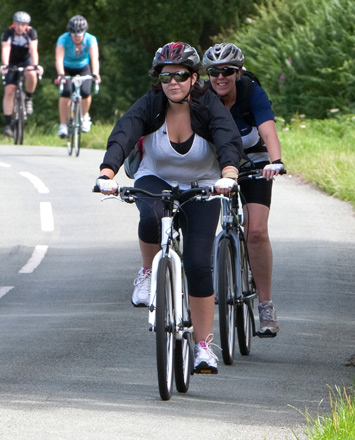|
Start your training by keeping it simple. If you can, try cycling to work one or two days a week - perhaps leave the house a little earlier than usual and take a longer route. Always start cycling slowly to warm up your muscles.
Vary your routes to keep things interesting and look for some hills to get experience of gear changing and to develop endurance. Learn to choose the right gears. For example, too low on the flat and you’ll find yourself pedalling frantically and wasting energy; try to change gear going too slowly up a steep hill and the chain can come off.
As your endurance and confidence grows, plan longer rides at weekends, increasing the distance as you get nearer the date of the ride itself. Try and identify an achievable and enjoyable destination that can be reached without using too many busy or main roads. Check out your local Sustrans routes – these usually follow quieter roads, often with traffic-free sections. Ride with friends to give each other moral support – it also helps to pace yourself against others.
Stretches and warm-ups prior to and after riding stretch muscles and help prevent cramp and stiffness. If you use a gym where there’s a personal trainer, ask for some advice about suitable stretches. And training for a ride doesn’t have to be just about cycling – swimming, running, yoga, etc. all develop muscle strength, cardio-vascular capacity, suppleness and all-round fitness.
|
|
 |
|

|
|
Remember, cycling uses energy. Take ‘energy foods’- bananas, nuts, fruit, sandwiches etc. – with you. And always take a full water bottle – it’s also thirsty work!
Following this kind of training program should be sufficient for riders taking part in our low to intermediate distance (up to 70 mile) rides and if you can cycle for a full hour without getting out of breath, you’re pretty much there. For those intending to enter our 100 mile (or ‘Century’) rides we recommend stepping up your training a little and this is down, largely, to ‘doing the miles’. If you can spare an hour a day, great!
As your cycling gets easier pick up your speed for stretches of the route or look for greater climbs which leave you a bit out of breath at the top. Try a longer ride of two hours at the weekend, if you can. Or cycle two hours at a time every other day, resting on the intervening days. Step up your training in this way but be careful not to push yourself too hard, and make sure you warm up properly and stretch afterwards. And you should, of course, enjoy it!
Lastly, be prepared. Remember to carry a puncture repair kit and pump with you (having learnt how to use them), along with a small medical kit, front and back lights, suncream and waterproof. We recommend that ALL riders bring and wear a cycling helmet for the duration of the event. There will a selection of helmets available for purchase at the Start (subject to availability). And bring a little money and your mobile phone, too – just in case.
|